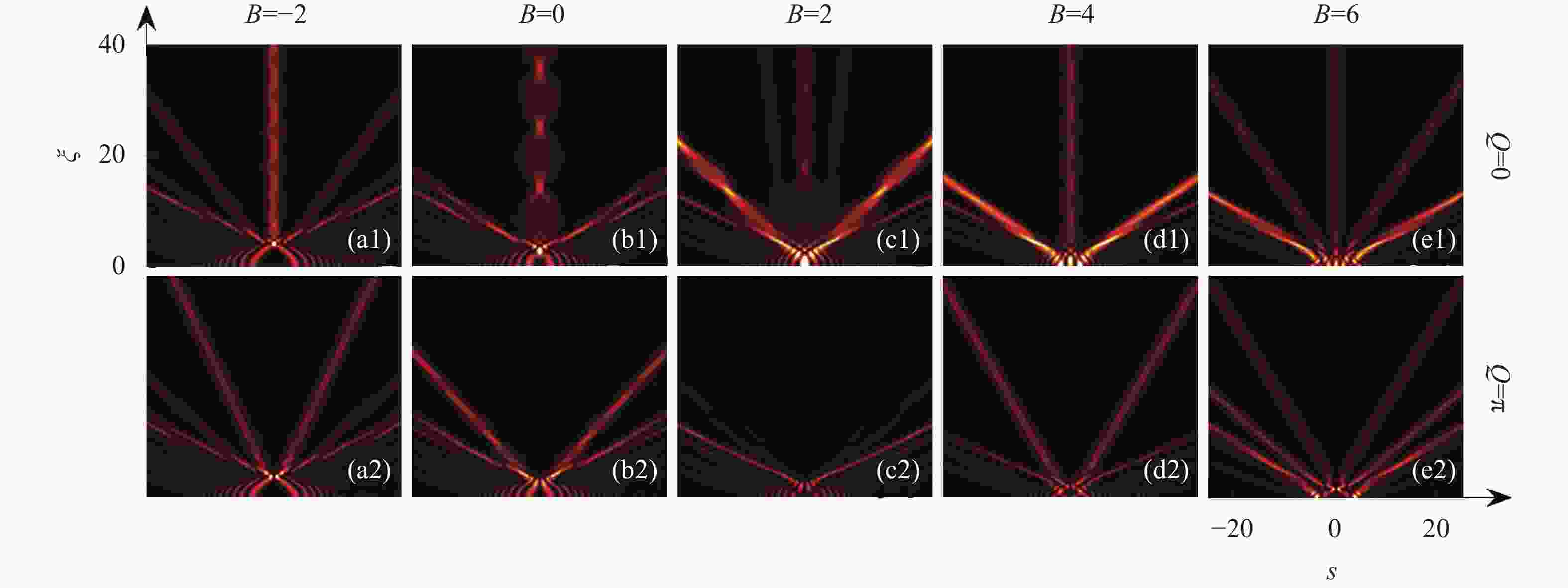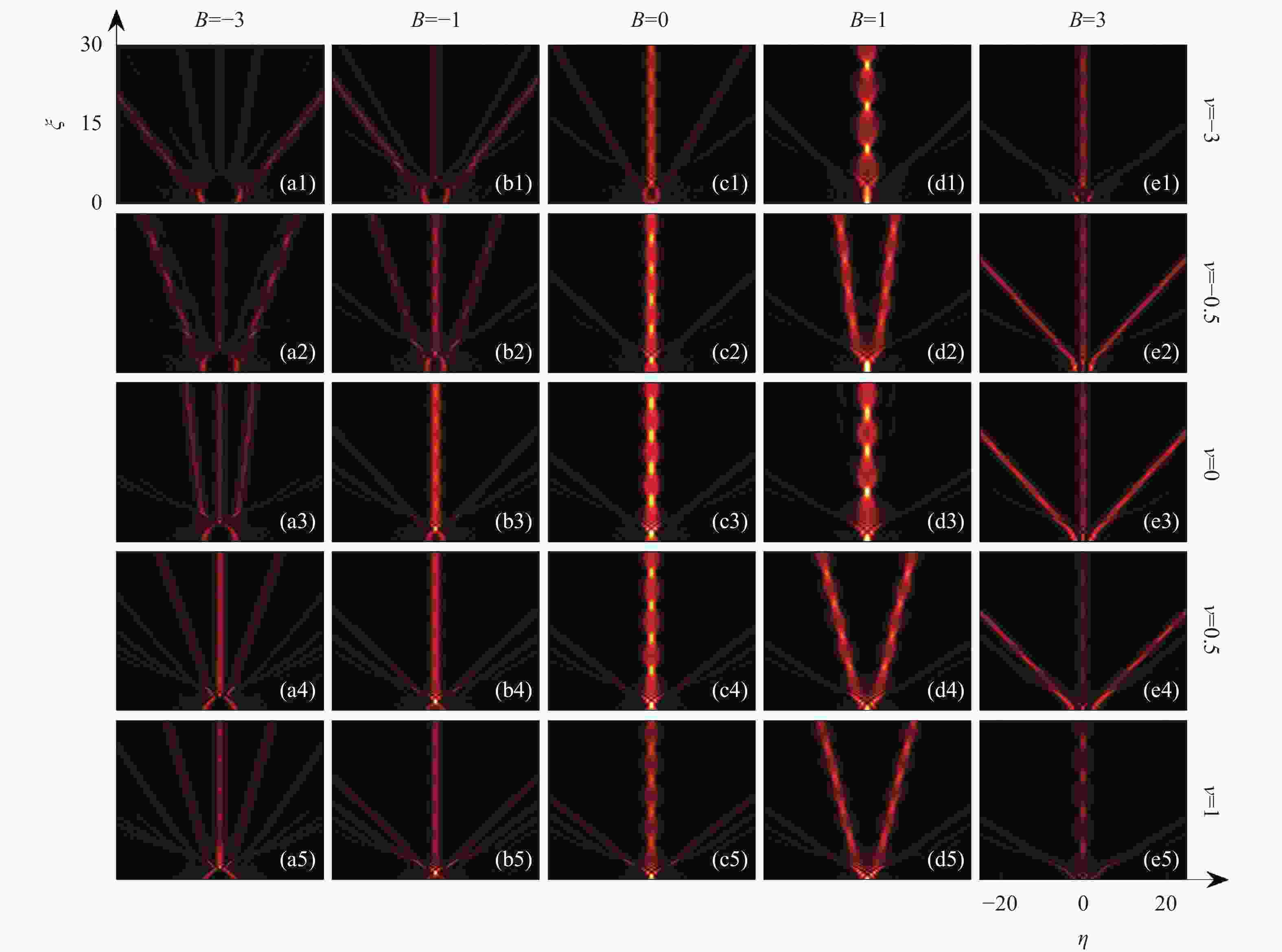-
有限能量艾里光束由于具有横向自加速特性和自愈特性等奇异特性而受到学界的广泛研究[1-2],在光子弹[3]、微粒清除[4]、弯曲的等离子体通道[5]、光通信路由[6]、光互连[7]、图像信号传输[8]、真空电子加速[9]及激光成丝[10]等方面具有重要的应用价值。此外,具有自加速特性的自陷光束,也称为非线性加速光束[11],是在非线性光学材料中形成的另一种具有横向自加速特性的光束,在同步共振辐射[12]及气液相中粒子的微观分布调控[13]等领域具有很高的潜在应用价值。目前,利用介质的非线性机制操控光束的演化是光场调控领域的重要手段之一,究其原因是光波在非线性光学材料中传播时而导致产生的一些新颖现象,比如在自散焦或自聚焦的非线性机制下可以形成亮暗空间孤子[14]和局域表面波[15]等。所以,许多研究人员对有限能量艾里光束或非线性加速光束在光学材料中的产生、传输、交互及调控等方面进行了深入的研究[16-38]。
通常,当单束有限能量艾里光束以一定初始振幅在非线性光学聚焦材料中传导时,部分能量会被非线性光学聚焦材料剥离产生单个或若干个呼吸孤子,剩余能量则在原加速轨迹上继续传输[16-21]。然而,当两束有限能量艾里光束或非线性加速光束在非线性光学材料中传输交互时会导致弯曲模式消失,在不同入射角度、初始间隔、相位差及初始振幅的情形下会产生不同的呼吸孤子或孤子对。比如,张贻齐团队对有限能量艾里光束和非线性加速光束在饱和与克尔非线性光学材料中的交互效应进行了研究,并指出处于同相位的两加速光由于相互吸引将形成具有束缚态的单呼吸孤子;处于反相位的两加速光由于排斥力会产生孤子对[22-23]。张美志团队对具有背景辐射的LiNbO3钙钛矿型晶体和光折变晶体中自加速光的交互效应进行了探究,并研究了它的瞬态特性[24-25]。Diebel等人对二维情况下多束有限能量艾里光束的交互效应进行了探究[26]。申明团队对有限能量艾里光束在向列相液晶中和非局域非线性光学材料中的交互进行了分析,并对有限能量艾里光束的非相干交互控制进行了讨论[27-29]。展凯云团队对有限能量艾里光束在扩散非线性光折变晶体中的交互效应进行深入分析后,提出可以通过改变光束入射角度对交互作用进行控制[30-31]。姜其畅团队对艾里高斯光束在中心对称光折变晶体中的交互特性进行了深入地分析[32]。笔者课题组也对竞争型非线性、饱和非线性和具有二次电光效应的光折变晶体中有限能量艾里光束的传输与交互作用进行了深层次研究[35-38]。此外,研究人员还利用分数阶效应调控有限能量艾里光束的传输和交互,并观察到了分裂孤子对、锯齿传输孤子对及大初始间隔光束间的相互吸引或排斥等新颖现象[39-43]。光伏光折变非线性一直以来都是研究人员研究光孤子形成的重要机制,与其他非线性机制相比,其主要特点是可以形成暗光伏孤子[44],在光开关的制备方面具有重要应用价值。笔者课题组利用光伏光折变非线性对艾里高斯光束传输特性已进行了较为详细的分析[45],但自加速光束在有偏压光伏光折变介质中的交互效应目前研究甚少。
文中采取分步傅里叶法(split-step Fourier method,SSFM),对有偏压光伏光折变晶体中自加速光束的交互效应进行数值分析,研究交互效应受系统参量调控影响。为其在全光信息处理及全光网络器件制备等领域的潜在应用奠定理论基础。
-
在不考虑背景辐照和扩散非线性,而仅考虑一维和傍轴近似的情况下,光伏光折变晶体中的光束传播归一化非线性Schrödinger方程可以描述为[44]:
式中:q为光场复振幅包络;经光束宽度x0和Rayleigh长度
$ kx_0^2 $ 归一化处理过的横纵坐标分别用η及ξ表示,k = k0ne为介质中的波数,其中ne为介质折射率,k0 = 2π/λ是真空中的波数,λ是入射光的波长;公式(1)左侧第三、四项分别描述的是漂移和光伏非线性效应,$\; \beta = {({k_0}{x_0})^2}(n_e^4{r_{eff}}/2){E_0} $ ,$ \alpha = {({k_0}{x_0})^2} (n_e^4{r_{eff}}/2){E_p} $ ,其中reff为有效电光系数,E0为外加电场,Ep为光伏场常数。若不考虑非线性作用,公式(1)存在艾里函数解$q(\eta ,\xi ) = {{Ai}}(\eta - {\xi ^2}/4)\exp (i\eta \xi /2 - i{\xi ^3}/12)$ ,式中艾里函数用Ai(∙)表达。虽然理想艾里光束在演化过程中能在横向方向进行自加速,但由于存在无穷能量振荡末尾,实际中不能实现。为此,参考文献[1]中提出了有限能量艾里光束解为:$q(\eta ,\xi = 0) = {{Ai}}(\eta )\exp (a\eta )$ ,其中a是衰减系数。若将两加速方向相反的有限能量艾里光束作为入射光场,对其交互作用进行研究时,光场表达式为:式中:A1与A2是可以调整两初始入射有限能量艾里光束功率的振幅参量;v是正比于光束入射角度的控制参量,v > 0表示光束加速被增强,v < 0表示光束加速被减弱;B为光束初始相对间隔;Q为两束有限能量艾里光束的相位差,则同相位用Q = 0表示,而反相位则用Q = π进行表示。
同时,引入加速坐标
$ \eta = s - {\xi ^2}/4 $ ,s为坐标变换后的横坐标,将该表达式代入公式(1)可得非线性加速解满足方程:设
$ q(s,\xi ) = u(s)\exp [i(s\xi /2 + {\xi ^3}/24)] $ 为所求加速解的表达形式,加速光的包络用u(s)来表示,将其代入公式(3)得:由于当
$ s $ 趋于$\infty $ 时光场的振幅趋于0,取公式(4)边界条件为$u(s) = \gamma {{Ai}}(s)$ 和$u'(s) = \gamma {{Ai'}}(s)$ ,其中s > 0,γ表示非线性强度系数。非线性加速光束的解通过求解公式(4)即可得到。为分析加速光束的交互作用,构造如下形式初始光束:式中:横向对称的非线性加速光束包络由u1与u2来表示,光束间隔由B调控,光束的相位差由Q调控。文中以LiNbO3晶体为例,参数取值:ne = 2.208,reff = 33 pm/V,Ep = –5 kV/cm,其他参数: λ = 0.488 μm,x0 = 0.04 mm。求得α = –5.2,通过调节偏压可以对参数β进行操控。
-
利用SSFM分析自加速特性光束交互效应受系统参量的影响。模拟与仿真过程中设置的光束传输步长是0.01z0(其中,z0是衍射距离),横向范围取点数为214个。由于间隔较大时光束间交互作用较弱[22-23],文中仅考虑光束间隔较小时的情况。
首先,考虑在存在偏压的光伏光折变介质中两束有限能量艾里光束的交互效应,把光强振幅的初始A1 和 A2 均取值为 4,参量β取值为 7.5,图1为同相位有限能量艾里光束的交互效应。当v为0时,由于相长干涉较强,导致光束间折射率升高,使两光束相互吸引,间隔较大时,吸引力较弱,处于中间位置的主瓣经过交叠形成单呼吸孤子,而处于两旁的旁瓣经交互形成了呼吸孤子对,如图1(a3)和(e3)所示;间隔较小时,吸引力较强,仅在中心位置处形成单呼吸孤子,见图1 (b3)~(d3)。当v不为 0时,对光束交互效应改变较大的因素是光束间隔和入射角度。首先,在v为负值时,光束加速受到了抑制,当B为负值时,孤子对间的斥力将随着v的绝对值的增加而变强,位于中间的单呼吸孤子峰值强度减弱,乃至出现了多孤子对,间隔越近,孤子对间斥力越弱,见图1(a1)~(b1)和(a2)~(b2)。当B取0后,单呼吸孤子最大值将减弱,具体见图1(c1)和(c2);若B取1,从图1(d2)可知,当v的绝对值逐渐降低并趋近于零时,位于中间的单呼吸孤子消失,光束经过急自聚焦后发生分叉,仅形成对称的呼吸式孤子对,这是因为光束初始叠加强度较大,由相长干涉导致的引力小于由入射方向导致的斥力,当v取 −1后,光束的交叠程度减弱,光束之间具有较高的引力,因此在交互过程中产生束缚态,见图1(d1)。当B取3时,光束的交叠程度较弱,孤子和孤子对同时出现,和B为负值时的情况相反的是,当v的绝对值逐渐增大,处于中间的呼吸式孤子峰值也越强,而孤子对的峰值却越弱。其次,光束的加速在v 为正值时被增强,交互过程中,当B为负值时,光束首先发生急自聚焦,并且随之光束之间的引力变大,非线性聚焦效应使旁瓣形成孤子对,见图1(a4)~(b4)以及(a5)~(b5);当B取0后,单呼吸孤子的峰值和v呈负相关,见图1(c4)及(c5);而当B取1时,光束将再次出现分叉,见图1(d4)以及(d5),成因和图1(d2)的类似;从图1(e4)及(e5)可知,当B取3后,结果类似于v为负值时的情形。
处于反相位的有限能量艾里光束交互效应结果如图2所示。可以看出,即使当光束在交互过程中发生相消干涉,导致光束之间折射率变小,光束之间发生排斥,但交互效应受入射方向v和光束距离B的影响更为显著。从图2(a3)~(e3)可知,若v值为0,在交互时,光束受到非线性和排斥效果的影响,导致了孤子对的出现,并且随着光束间距变小,排斥力将变大。当v为负值时,若B不为正值,光束的加速被来自负入射角度的作用所抑制,除了光束主瓣,旁瓣间的排斥现象也均较为显著,从而产生多孤子对,见图2(a1)~(c1)及(a2)~(c2),且光束间的斥力与间隔绝对值成反比;从图2(d1)及(d2)可知,当B取1时,由于光场叠加强度较大,折射率受相消干涉影响将再次变小,使得光束间表现出较强的排斥力;当B取3时,随着相消干涉影响变小,光束间的排斥力也减弱,奇特的是,图2(e1)中所示的光束经过交互先发生吸引,而后发生弹性碰撞,继而发生排斥,产生这种情况的主因是存在较大的负入射角。在B不为正值的情况下,若v为正值,光束间将首先发生吸引而后发生排斥,进而产生多孤子对;若B为正值,情况与v为负值且B为正值时的类似,此处不再赘述。总之,光束间距和入射方向可以改变光束之间斥力,导致多孤子对产生。光束间距越小,光束间排斥力越大;间距较大时,斥力与v的绝对值成正相关;间距较小时,斥力与v的绝对值成负相关。

Figure 2. Interaction of two out-of-phase Airy beams with different beams separation and incident angle
为了研究有限能量艾里光束交互效应受到非线性作用影响,通过对β参量的调整,继续实施仿真分析,结果如图3所示。当β取0时,由图3(a1)~(a3)可知,在散焦效应作用下,没有孤子或孤子对在交互过程中产生。一旦α和β的和为正值,非线性效应将从散焦效果转换为聚焦效果[43]。由图3(b1)~(e1)可知,在光束间隔较小的情况下,当聚焦效果变强时,处于同相位的有限能量艾里光束在交互过程中不但会产生单呼吸孤子和孤子对,还能使单呼吸孤子的峰值升高,呼吸周期减小。由图3(b2)~(e2)可知,当光束存在较小间距,处于反相位的有限能量艾里光束交互过程中会随着增强的聚焦效应而发生排斥,进而产生呼吸孤子对或多孤子对,从主瓣脱离产生的孤子对斥力逐渐减弱,峰值逐渐增强,呼吸周期逐渐减小。从图3(d3)和(e3)可知,当光束间隔较大时,在强聚焦效应作用下,同相位艾里光束交互过程中发生分叉。

Figure 3. Interaction of two Airy beams with selected β. (a1)-(e1) In-phase with B = −1; (a2)-(e2) out-of-phase with B = −1; (a3)-(e3) In-phase with B = −2
通过求解公式(4),以便分析有偏压光伏光折变光学介质中非线性加速光束产生的交互效应,参数γ取10和β取7条件下加速光束的包络振幅如图4(a)所示,非线性加速光束主瓣的强度峰值大约位于s为−2.17处,显然,非线性加速光束具有类似于艾里光束的无穷振荡末尾。图4(b)对非线性加速光束的演化过程进行了模拟,可以看出,该光束同时具备横向自加速特征以及无衍射特征。然而,为了将其能量限制在有限范围,仿真中对非线性加速光束切趾,只保留包括主瓣在内的10个光瓣。图4(c)为切趾后的非线性加速光传播情况,演化时光束能量处于发散状态,因而没有孤子产生。

Figure 4. (a) Intensity of nonlinear accelerating beam with β = 7 and γ = 10; (b) Propagating of accelerating solution and (c) truncated acceleration solution
以公式(5)为初始条件,对两束非线性切趾加速光束的交互效应仿真研究,结果如图5所示。因为主瓣峰值位置向左偏移约2个单位距离,因此在仿真时对B取值为2的周围几个稍小间隔的情形进行分析。由图5(a1)~(e1)可知,当光束处于同相位条件下时,光束将在交互时相互吸引并产生奇数个孤子(包含孤子对)。在B大于等于2时,和有限能量艾里光束交互效应不同,强的光场交叠使衍射效果远小于自聚焦效果,处于中间的单呼吸式孤子的峰值远小于孤子对峰值。从图5(a2)~(e2)可知,当光束处于反相位,在交互时相互吸引并产生偶数个孤子对,排斥力与光束间距的绝对值成反比。

Figure 5. Interaction of two nonlinear truncated accelerating beams with selected B. (a1)-(e1) In-phase case; (a2)-(e2) Out-of-phase case
最后,分析非线性加速光束交互结果受来自非线性聚焦作用的影响,如图6所示。可以看出,不管有限能量艾里光束处于同相位抑或是反相位,在交互后剥离出的孤子抑或是孤子对的峰值都和β成正相关;而呼吸周期则与β成负相关。而对于处于反相位的非线性加速光束来说,孤子对间的排斥力是逐渐增强的,而有限能量艾里光束在有偏压光伏光折变介质中交互效应的规律则恰好相反。
-
数值分析了艾里光束和非线性加速光束在有偏压光伏光折变介质中的交互效应。有偏压且聚焦时,同相位有限能量艾里光束相互吸引,可产生呼吸孤子与孤子对;反相位有限能量艾里光束相互排斥,出现呼吸孤子对。调节入射角度参量v和初始间隔B可操控光束交互。同相位条件下,在v为负值时,若B不为正值,B越小,单呼吸孤子强度越小,孤子对斥力越大;若B为正值,间隔较小时会出现光束分叉现象,分叉现象会随着光束间隔的增加而消失。在v为正值时,若B不为正值,B越小,单呼吸孤子强度和孤子对斥力均越小;若B为正值,间隔较小时同样会出现光束分叉现象。反相位条件下,光束交互表现出弱吸引力和强排斥力,间隔较小时,v绝对值变大会导致斥力变小,间隔较大时,v绝对值变大会导致斥力变大。非线性聚焦强度增加时,间隔较小的同相位和反相位有限能量艾里光束交互时形成的孤子或孤子对峰值强度均单调递增,呼吸周期单调递减,间隔和非线性聚焦强度系数较大时,会出现分叉孤子。当非线性切趾加速光束发生交互时,同相位光束相互吸引,光束间距B大于等于2时单呼吸孤子峰值远小于孤子对峰值;反相位光束相互排斥,产生多孤子对。孤子或孤子对的峰值和非线性聚焦效应成正相关;呼吸周期和非线性聚焦效应呈负相关。
Theoretical study on interaction effect of self-accelerating beams in a biased photovoltaic photorefractive crystal
doi: 10.3788/IRLA20220096
- Received Date: 2022-01-10
- Rev Recd Date: 2022-02-25
- Accepted Date: 2022-03-07
- Publish Date: 2022-07-05
-
Key words:
- nonlinear optics /
- Airy beam /
- interaction /
- light field regulation
Abstract: Investigation on the interactions of Airy and nonlinear accelerating beams in a biased photovoltaic-photorefractive crystal was presented theoretically by means of split-step Fourier method. The results shown that, by adjusting the initial beams interval and incident angle, two finite-energy Airy beams in the in-phase or out-of-phase case can attract or repel each other. In the in-phase case, not only single breathing solitons and soliton pairs can generate, but also splitting solitons with oscillation are obtained. While only soliton pairs can be formed in the out-of-phase case. Interaction of two in-phase nonlinear truncated accelerating beams can generate an odd number of breathing solitons, and an even number of soliton pairs can be produced in the out-of-phase case. Moreover, the peak intensity, breathing period and magnitude of the interaction force of the breathing solitons can be effectively regulated by adjusting the external bias and the incident angle. The results can provide a theoretical basis for the interaction regulation of Airy beams, and also have potential application prospects in the fields of all-optical information processing and optical network device fabrication.























 DownLoad:
DownLoad:




